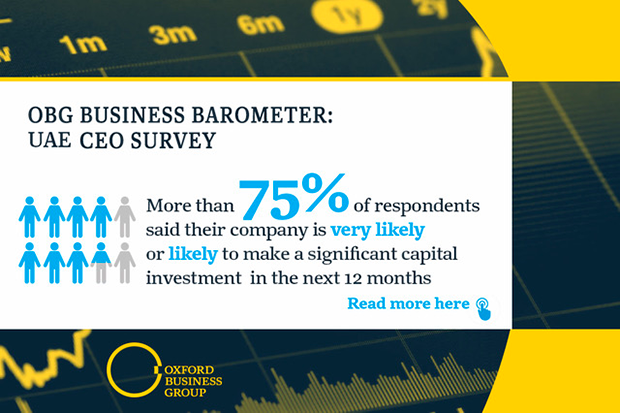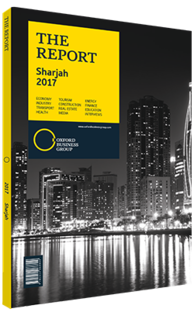Sharjah takes a range of measures to address deficit
The government of Sharjah has consistently run small fiscal deficits in recent years. Against a backdrop of falling oil prices, the deficit has outstripped economic growth, generating rising levels of public debt. However, these remain modest as a proportion of economic output. Furthermore, the government has also recently taken a range of measures to reduce the costs of servicing its debt, which should allow for substantial room for it to continue borrowing in the coming years in order to invest in infrastructure and stimulate long-term economic growth.
Managing A Deficit
According to Moody’s, the emirate’s government has consistently run fiscal deficits since 2007. The shortfalls remained very small and largely below GDP growth for most of the period, ranging in size between 0.3% and 2.5% of GDP until 2013. However, against a backdrop of falling oil prices, the figure rose from 1.3% in 2013 to 2.7% in 2014 and 4.2% in 2014. Mathias Angonin, sovereign risk group lead analyst at Moody’s Investors Service Middle East, told OBG this was much higher than had been expected. He said, “This was partly because previously planned land sales were delayed as the market conditions were not right. The authorities also paid some local contractors and other companies in advance in order to support the segment during the downturn.”
The deficit is, however, likely to have fallen substantially in 2016. A November 2016 report from Moody’s for the emirate forecast the figure to stand at 2.1% of GDP for 2016 as a whole. However, speaking to OBG in December 2016, Angonin said that the deficit figure was likely to come in slightly higher than the government’s targets. “Land sales were delayed again and the targets were ambitious,” he explained to OBG.
Tom Koczwara, director of the Debt Management Office at Sharjah’s Department of Finance, told OBG government revenues for 2016 had performed well, which should have helped to limit the shortfall. “Revenues are roughly in line with our targets and are up significantly on 2015 figures,” he told OBG in December 2016. “Land sale revenues will be down a little as the real estate market has been soft, but commercially driven revenues have risen strongly as commercial activity has been better than many people expected, and we have also introduced some new revenue-raising initiatives such as auctioning licence plates,” he said, noting that the authorities had also raised the cost of some fees in 2016. The deficit should fall further in 2017. In January 2017 state press agency WAM reported that the Sharjah’s government had approved a 3% rise in the value of state spending for the 2017 budget, for a total of Dh22bn ($6bn), while revenues are scheduled to increase by 7%. Around 40% of total spending under the budget will go to public sector wages and around 30% on infrastructure investment.
Rising Debt
As a result of the growth in the deficit, debt levels have been rising in recent years, albeit from very low levels. Government debt was equivalent in value to 13.3% of GDP at the end of 2015, according to figures from Moody’s, up from 9.9% in 2014 and 4% in 2010. In November 2016 the credit agency forecast the figure to rise to 15.7% of GDP for the year as a whole. Koczwara told OBG the debt had mainly been used to finance capital expenditure, in particular the construction of housing and infrastructure such as roads and government buildings, though he added that there had also been some borrowing in 2015 to cover current expenditure due to a slowdown in land sales and other factors. He added that the authorities aimed to continue to borrow to fund capital expenditure in order to boost long-term growth and that the government currently had no long-term debt target or ceiling. “There is lots of space for further borrowing given that debt levels are currently very low as a percentage of GDP, which gives us flexibility to react to economic circumstances,” he told OBG.
Benjamin Young, the associate director for sovereign and international public finance ratings at Standard & Poor’s (S&P) Global Ratings, agreed that the government had plenty of room for manoeuvre regarding its debt levels. “Although we have seen material increases in government indebtedness over the past few years, which in part was a factor in our recent rating action, Sharjah is a long way from any traditional debt sustainability threshold,” Young told OBG, adding that the agency was also comfortable that the federal government would provide support for the Sharjah authorities should the emirate ever find itself in financial difficulties.
“Debt levels are very low for an A-rated sovereign,” Angonin told OBG, noting that, for example, those of Malaysia, which is also A-rated, are currently at around 50%. Angonin added that the Sharjah authorities have large amounts of land available for sale should they find themselves in need of additional revenues, noting that there has been consistent demand for previous sales. However, Angonin stated that there are some weaknesses in the emirate’s profile. “While debt to GDP is low, levels of debt are higher compared to government revenues,” he told OBG by way of explanation for the rating not being higher. The value of government debt rose to 270% of revenue in 2015, almost double the 2014 figure, though as of November 2016 Moody’s expected it to fall back to 228% for the year. “Furthermore, unlike some other emirates such as Ras Al Khaimah, Sharjah does not have a major portfolio of companies that it can rely on for dividend payments in difficult times,” Angonin added.
Debt Management
In 2014 and 2015 the government undertook an initiative to reformulate its debt. A key element of this was the issuing of two sukuk (Islamic bonds) to finance the repayment of multiple smaller loans that attracted higher interest rates, much of it in the form of bank credit. The authorities also engaged in several private transactions to raise new, cheaper funds in order to repay older more expensive loans. Koczwara told OBG that the programme had been successful, bringing down debt costs by around 50%. In 2015 and 2016 the emirate used a similar approach to reformulate the debts of government-related entities. “Despite weakening as a result of counter-cyclical policy measures designed to offset lower growth, Sharjah public finances remain relatively strong, with moderate levels of net debt estimated at 15% of GDP in 2017,” Young told OBG.
Ratings
Another move that has likely reduced the cost of the emirate’s debt was its decision in 2013, ahead of its first sukuk issue the following year, to be rated as an issuer of debt by credit rating agencies Moody’s and S&P. Both agencies rate the government’s debt issues as investment grade, with Moody’s giving it an issuer rating of “A3” – four notches below UAE as a whole – on a stable outlook. S&P ranked Sharjah “A/A-1”, but later downgraded the emirate in January 2017. Young told OBG, “Following our negative outlook, assigned in August 2016 on the basis of slower growth expectations and a sharp downward revision to GDP per capita, we lowered our ratings from ‘A’ to ‘BBB+’ in January 2017, reflecting the impact of this pressure on public finances – while manageable, net debt has increased fourfold from 2.6% of GDP in 2014 to 15% in 2017. We expect a slower pace of fiscal consolidation going forward. GDP per capita matters in our analysis because it implies a reduced wealth base for the government to draw upon and ratings are about the repayment of financial obligations.” Similarly, Angonin cited worse-than-expected fiscal performance as a risk, explaining this could lead to Moody’s stable outlook turning negative, but added that other potential developments, such as a stabilisation in the financial position of the Sharjah Electricity and Water Authority (SEWA), could also see it move to a positive outlook.
Cutting Subsidies
A recent development that has boosted the state of public finances and will help to reduce the deficit is the termination of government subsidies to SEWA. The firm had until recently been buying fuel at market prices, including expensive fuel oil during periods when it ran short of gas supplies, while simultaneously selling electricity at a fixed, lower price, giving rise to a shortfall that the government had to cover with a subsidy. However, a fall in fuel prices in recent years, as a result of the drop in oil prices since mid-2014 and 2015, has helped to reduce the shortfall, and the utility has also taken new measures such as obliging public entities that were not previously required to pay for utilities, as well as steps to improve debt collection.
The UAE’s Dolphin Energy in October 2016 also signed a deal for the provision of additional gas supplies from Qatar, some of which will be provided to Sharjah, which will further support the authority. “The [Dolphin] deal is credit positive for Sharjah as SEWA will likely receive gas at below market prices over the long term, reducing the risk of a spike in its cost should the oil price rise again,” said Angonin. Koczwara told OBG that as a result of such measures, the authority will be able to continue to stand on its own two feet, even if oil prices rise substantially in the future.
You have reached the limit of premium articles you can view for free.
Choose from the options below to purchase print or digital editions of our Reports. You can also purchase a website subscription giving you unlimited access to all of our Reports online for 12 months.
If you have already purchased this Report or have a website subscription, please login to continue.


